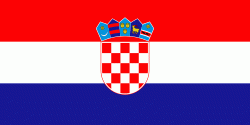Rovinj (Grad Rovinj)
Rovinj (Rovigno; Istriot: Ruvèigno or Ruveîgno; Ρυγίνιον; Ruginium) is a city in Croatia situated on the north Adriatic Sea with a population of 14,294 (2011). Located on the western coast of the Istrian peninsula, it is a popular tourist resort and an active fishing port. Istriot, a Romance language once widely spoken in this part of Istria, is still spoken by some of the residents. The town is officially bilingual, Croatian and Italian, hence both town names are official and equal.
Rovinj/Rovigno was already a settlement of Venetian or Illyrian tribes before being captured by the Romans, who called it Arupinium or Mons Rubineus, and later Ruginium and Ruvinium. Built on an island close to the coast, it became connected to the mainland much later, in 1763, by filling in the channel.
Rovinj/Rovigno was eventually incorporated into the Byzantine Empire, later becoming part of the Exarchate of Ravenna in the 6th century, before being taken over by the Frankish Empire in 788. For the following several centuries it was ruled by a succession of feudal lords, and in 1209 it was acquired by the Patriarchate of Aquileia under Wolfger von Erla.
From 1283 to 1797 Rovinj was one of the most important towns in Istria governed by the Republic of Venice. During this period three town gates were constructed and Rovinj/Rovigno was fortified by two rows of defensive walls, remains of which can still be seen today. Nearby the Rovinj/Rovigno pier one can find one of the old town gates, the Balbi's Arch, dating from 1680, and a late-Renaissance clock tower. The first city statute was proclaimed in 1531.
Following the fall of Venice in 1797 and the ensuing Napoleonic interlude, Rovinj/Rovigno became part of the Austrian Empire, which lasted until World War I. According to the last Austrian census in 1911, 97.8% of the population was Italian-speaking. It then belonged to Kingdom of Italy from 1918 to 1947, when it was ceded to SFR Yugoslavia, as part of SR Croatia. The original town name Rovigno was then changed into Rovinj. During the post-war period, many Italian inhabitants left Rovinj, which led to significant changes to the city's demographic structure.
Following Croatia's independence in 1991, the town became one of the most important centers of Istria County, an administrative unit encompassing most of Istria. Rovinj/Rovigno is today the third most populous town in the county, behind Pula and Poreč.
Rovinj/Rovigno was already a settlement of Venetian or Illyrian tribes before being captured by the Romans, who called it Arupinium or Mons Rubineus, and later Ruginium and Ruvinium. Built on an island close to the coast, it became connected to the mainland much later, in 1763, by filling in the channel.
Rovinj/Rovigno was eventually incorporated into the Byzantine Empire, later becoming part of the Exarchate of Ravenna in the 6th century, before being taken over by the Frankish Empire in 788. For the following several centuries it was ruled by a succession of feudal lords, and in 1209 it was acquired by the Patriarchate of Aquileia under Wolfger von Erla.
From 1283 to 1797 Rovinj was one of the most important towns in Istria governed by the Republic of Venice. During this period three town gates were constructed and Rovinj/Rovigno was fortified by two rows of defensive walls, remains of which can still be seen today. Nearby the Rovinj/Rovigno pier one can find one of the old town gates, the Balbi's Arch, dating from 1680, and a late-Renaissance clock tower. The first city statute was proclaimed in 1531.
Following the fall of Venice in 1797 and the ensuing Napoleonic interlude, Rovinj/Rovigno became part of the Austrian Empire, which lasted until World War I. According to the last Austrian census in 1911, 97.8% of the population was Italian-speaking. It then belonged to Kingdom of Italy from 1918 to 1947, when it was ceded to SFR Yugoslavia, as part of SR Croatia. The original town name Rovigno was then changed into Rovinj. During the post-war period, many Italian inhabitants left Rovinj, which led to significant changes to the city's demographic structure.
Following Croatia's independence in 1991, the town became one of the most important centers of Istria County, an administrative unit encompassing most of Istria. Rovinj/Rovigno is today the third most populous town in the county, behind Pula and Poreč.
Map - Rovinj (Grad Rovinj)
Map
Country - Croatia
Currency / Language
| ISO | Currency | Symbol | Significant figures |
|---|---|---|---|
| HRK | Croatian kuna | kn | 2 |
| ISO | Language |
|---|---|
| HR | Croatian language |
| SR | Serbian language |


















